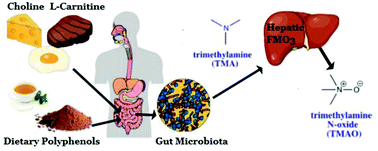当前位置:
X-MOL 学术
›
Food Funct.
›
论文详情
Our official English website, www.x-mol.net, welcomes your
feedback! (Note: you will need to create a separate account there.)
Impact of short-term flavanol supplementation on fasting plasma trimethylamine N-oxide concentrations in obese adults†
Food & Function ( IF 5.1 ) Pub Date : 2018-09-25 00:00:00 , DOI: 10.1039/c8fo00962g Chris J. Angiletta 1, 2, 3, 4, 5 , Laura E. Griffin 4, 5, 6, 7 , Cortney N. Steele 1, 2, 3, 4, 5 , David J. Baer 8, 9, 10, 11, 12 , Janet A. Novotny 8, 9, 10, 11, 12 , Kevin P. Davy 1, 2, 3, 4, 5 , Andrew P. Neilson 4, 5, 6, 7
Food & Function ( IF 5.1 ) Pub Date : 2018-09-25 00:00:00 , DOI: 10.1039/c8fo00962g Chris J. Angiletta 1, 2, 3, 4, 5 , Laura E. Griffin 4, 5, 6, 7 , Cortney N. Steele 1, 2, 3, 4, 5 , David J. Baer 8, 9, 10, 11, 12 , Janet A. Novotny 8, 9, 10, 11, 12 , Kevin P. Davy 1, 2, 3, 4, 5 , Andrew P. Neilson 4, 5, 6, 7
Affiliation

|
The gut microbiome metabolizes choline and carnitine to release trimethylamine (TMA), which subsequently undergoes hepatic conversion to trimethylamine N-oxide (TMAO). Elevated TMAO levels are associated with cardiovascular disease and all-cause mortality risk. Dietary flavanols modulate the composition and function of the gut microbiome. Therefore, the possibility exists that these compounds could reduce intestinal TMA production and lower circulating TMAO. However, this hypothesis has never been tested in humans. A secondary analysis was performed on blood samples from a clinical study in which obese subjects at risk for insulin resistance consumed tea or cocoa flavanols in a randomized crossover design while consuming a controlled diet. These subjects generally had elevated TMAO levels (∼5 μM) compared to levels previously measured in healthy subjects (∼1 μM). None of the interventions significantly altered TMAO levels. Individual variability for choline and carnitine was relatively low. However, TMAO exhibited somewhat greater inter-individual variability. No differences in mean TMAO concentrations observed across interventions were seen based on separating subjects by glycemic status, body mass index (BMI), race, age, or gender. However, subject minimum and maximum values observed across the interventions appeared to be more strongly associated with glycemic status and age than mean values across interventions, suggesting that average TMAO values over time may be less useful than maximum or minimum values as markers of disease risk. Traditional physiological characteristics do not appear to predict TMAO responsiveness to flavanol interventions. However, African-American subjects appeared less responsive compared to non-Hispanic white subjects for both green tea and high cocoa treatments, and female subjects appeared less responsive than males for the high cocoa treatment. The present results suggest that a short-term flavanol intervention does not generally reduce fasting TMAO levels in subjects with elevated circulating TMAO.
中文翻译:

短期补充黄烷醇对肥胖成年人禁食血浆三甲胺N-氧化物浓度的影响†
肠道微生物组代谢胆碱和肉碱释放三甲胺(TMA),随后将其肝脏转化为三甲胺N-氧化物(TMAO)。TMAO水平升高与心血管疾病和全因死亡风险相关。膳食黄烷醇调节肠道微生物组的组成和功能。因此,这些化合物可能会降低肠道TMA的产生并降低循环TMAO。但是,这一假设从未在人类中得到检验。对来自一项临床研究的血液样本进行了次要分析,在该研究中,有胰岛素抵抗风险的肥胖受试者在随机对照设计中食用茶或可可黄烷醇,同时食用受控饮食。与先前在健康受试者中测得的水平(〜1μM)相比,这些受试者通常具有较高的TMAO水平(〜5μM)。所有干预措施均未显着改变TMAO水平。胆碱和肉碱的个体变异性相对较低。但是,TMAO表现出更大的个体间变异性。根据血糖状况,体重指数(BMI),种族,年龄或性别对受试者进行分类,在干预措施中观察到的平均TMAO浓度无差异。然而,在干预措施中观察到的受试者最小值和最大值似乎比在干预措施中的平均值与血糖状况和年龄更密切相关,这表明随着时间的推移,平均TMAO值可能不如最大值或最小值作为疾病风险的标志物有用。传统的生理特征似乎无法预测TMAO对黄烷醇干预的反应。但是,与非西班牙裔白人受试者相比,非裔美国人受试者在绿茶和高可可治疗方面的反应较弱,在高可可治疗中,女性受试者的反应性不如男性。目前的结果表明,短期黄烷醇干预一般不会降低循环TMAO升高的受试者的空腹TMAO水平。
更新日期:2018-09-25
中文翻译:

短期补充黄烷醇对肥胖成年人禁食血浆三甲胺N-氧化物浓度的影响†
肠道微生物组代谢胆碱和肉碱释放三甲胺(TMA),随后将其肝脏转化为三甲胺N-氧化物(TMAO)。TMAO水平升高与心血管疾病和全因死亡风险相关。膳食黄烷醇调节肠道微生物组的组成和功能。因此,这些化合物可能会降低肠道TMA的产生并降低循环TMAO。但是,这一假设从未在人类中得到检验。对来自一项临床研究的血液样本进行了次要分析,在该研究中,有胰岛素抵抗风险的肥胖受试者在随机对照设计中食用茶或可可黄烷醇,同时食用受控饮食。与先前在健康受试者中测得的水平(〜1μM)相比,这些受试者通常具有较高的TMAO水平(〜5μM)。所有干预措施均未显着改变TMAO水平。胆碱和肉碱的个体变异性相对较低。但是,TMAO表现出更大的个体间变异性。根据血糖状况,体重指数(BMI),种族,年龄或性别对受试者进行分类,在干预措施中观察到的平均TMAO浓度无差异。然而,在干预措施中观察到的受试者最小值和最大值似乎比在干预措施中的平均值与血糖状况和年龄更密切相关,这表明随着时间的推移,平均TMAO值可能不如最大值或最小值作为疾病风险的标志物有用。传统的生理特征似乎无法预测TMAO对黄烷醇干预的反应。但是,与非西班牙裔白人受试者相比,非裔美国人受试者在绿茶和高可可治疗方面的反应较弱,在高可可治疗中,女性受试者的反应性不如男性。目前的结果表明,短期黄烷醇干预一般不会降低循环TMAO升高的受试者的空腹TMAO水平。










































 京公网安备 11010802027423号
京公网安备 11010802027423号